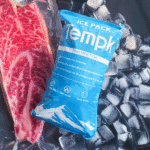Einführung in die Produkte Kaltkette kalten Produkte sind ein wesentlicher Bestandteil der modernen Logistik und des Transports, speziell für temperaturempfindliche Güter wie Lebensmittel und Arzneimittel. Die Weiterentwicklung der Kaltkettentechnologie hat die Sicherheit erheblich verbessert, Qualität, und Marktreichweite dieser Produkte. In diesem Leitfaden, Wir werden das Konzept untersuchen, Typen, Technische Prinzipien, Branchenanwendungen, und zukünftige Trends von Kaltkettenprodukten.
Was sind Kaltkettenprodukte? Kaltkettenprodukte sind Artikel, die während ihrer Produktion innerhalb eines bestimmten Temperaturbereichs aufbewahrt werden müssen, Lagerung, Transport, und Verkauf. Dieser Prozess umfasst spezielle Geräte und Technologie, um sicherzustellen. Zu den wichtigsten Kategorien gehören gekühlte Lebensmittel, Tiefkühlkost, frische Produkte, Arzneimittel, und biologische Materialien.
Types of Cold Chain Products
Lebensmittelprodukte
Kühlkost: Artikel wie Milch- und Milchprodukte erfordern eine Lagerung zwischen 0 ° C und 4 ° C, um Verderb zu vermeiden.
Gefrorene Lebensmittel: Products such as ice cream and frozen vegetables must be kept below -18°C to maintain their quality.
Pharmazeutische Produkte
Vaccines and Medications: These products often need storage at 2°C to 8°C, with some requiring ultra-low temperatures, such as -80°C, to ensure efficacy.
Biological Products
Zellen, Tissues, and Samples: Used in medical and research fields, these products require stringent temperature control, often stored at cryogenic temperatures like -196°C.
Chemische Produkte
Sensitive Chemicals: Certain reagents and reactants need to be kept within specific temperature ranges to prevent degradation or unwanted reactions.
Key Technologies in Cold Chain Management
Effective cold chain management relies on several key technologies:
Kühlgeräte
Essential for maintaining low temperatures, einschließlich gekühlter LKWs, Kühlspeicher, and containers.
Temperaturüberwachungssysteme
Real-time monitoring tools like sensors and data loggers ensure temperature stability throughout the supply chain.
Isolationsmaterialien
Advanced materials like vacuum insulated panels (VIP) and polyurethane (Pu) help maintain desired temperatures by minimizing external heat impact.
Kältemittel
Substances like freon and ammonia are used to absorb and remove heat, keeping products at the required temperatures.
Applications of Cold Chain Products Across Industries
Lebensmittelindustrie
Cold chain logistics ensure that fresh produce, Fleisch, and seafood maintain their quality from farm to table, reducing food waste and extending shelf life.
Pharmaindustrie
Essential for the safe storage and transportation of vaccines, Blutprodukte, and biopharmaceuticals, ensuring their efficacy and safety.
Biotechnology Industry
Critical for the transportation and storage of biological samples, ensuring their stability for research and clinical use.
Chemical Industry
Used to maintain the stability of temperature-sensitive chemicals during transportation and storage.
Current Trends and Future of Cold Chain Products
The cold chain market is experiencing rapid growth due to increased demand for food safety, Gesundheitspflege, und Biotechnologie. Here are the key trends:
Marktwachstum
The global cold chain market is projected to reach billions of dollars by 2025, driven by rising consumer awareness and demand for temperature-sensitive products.
Technologische Fortschritte
IoT and Big Data: Real-time monitoring and data analysis are optimizing cold chain management.
Blockchain: Enhances transparency and traceability in the cold chain.
New Insulation Materials: Innovations like VIP and PCM are improving cold chain efficiency.
Infrastructure Development
Investment in cold storage and transport vehicles is increasing, particularly in emerging markets, to meet growing demand.
Policy and Standards
Governments and international organizations are supporting cold chain development with favorable policies and industry standards to ensure product safety and quality.
Herausforderungen
Hohe Kosten: Cold chain logistics are expensive, particularly for SMEs.
Technical Complexities: Ensuring temperature stability during long-distance transport remains a challenge.
Standardization Issues: Differences in standards across regions complicate cross-border cold chain logistics.
Future Trends in Cold Chain Products
Intelligent Systems
The integration of IoT and big data is leading to smarter cold chain systems that optimize temperature control and improve efficiency.
Ökologische Nachhaltigkeit
The future of cold chain products will focus on using eco-friendly refrigerants and materials to minimize environmental impact.
Globalization
With the rise of cross-border e-commerce, cold chain products are becoming increasingly important in global markets.
Anpassung
Die Nachfrage nach personalized cold chain solutions is driving innovation, with companies focusing on customized packaging and transportation to meet specific customer needs.
Conclusion Cold chain products are critical to ensuring the safety and quality of temperature-sensitive goods in the food, pharmazeutisch, und Biotechnologieindustrie. As technology advances and market demands evolve, the cold chain industry will continue to grow, with intelligent, nachhaltig, global, and personalized solutions leading the way.






















